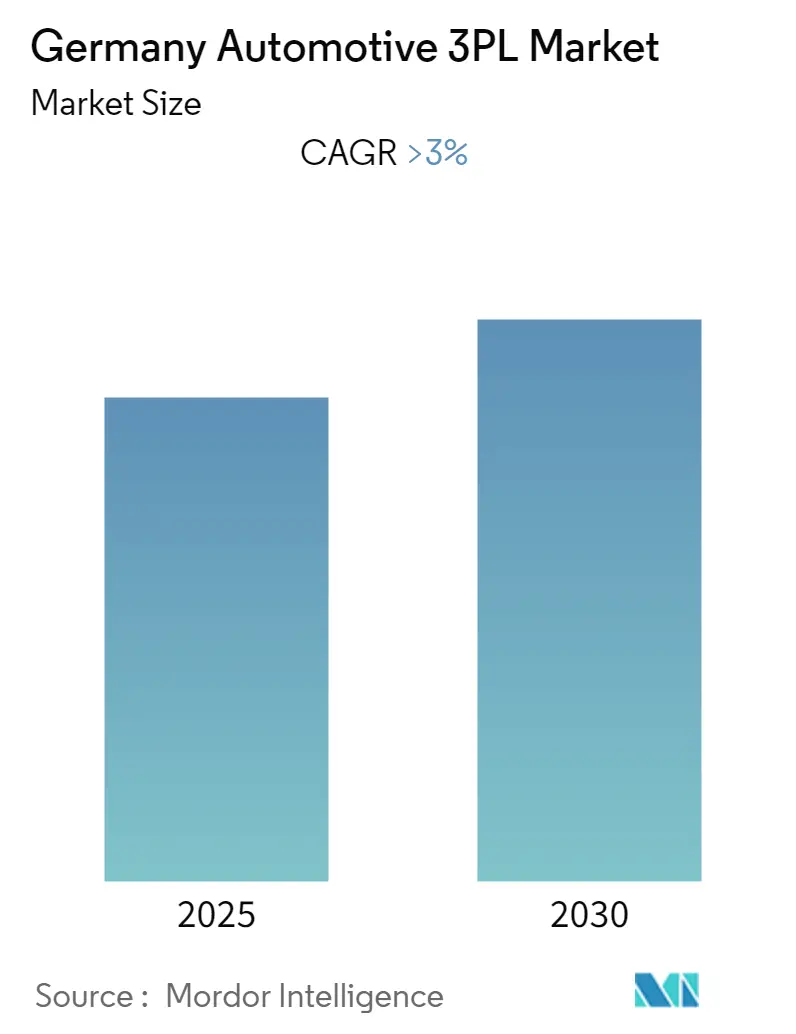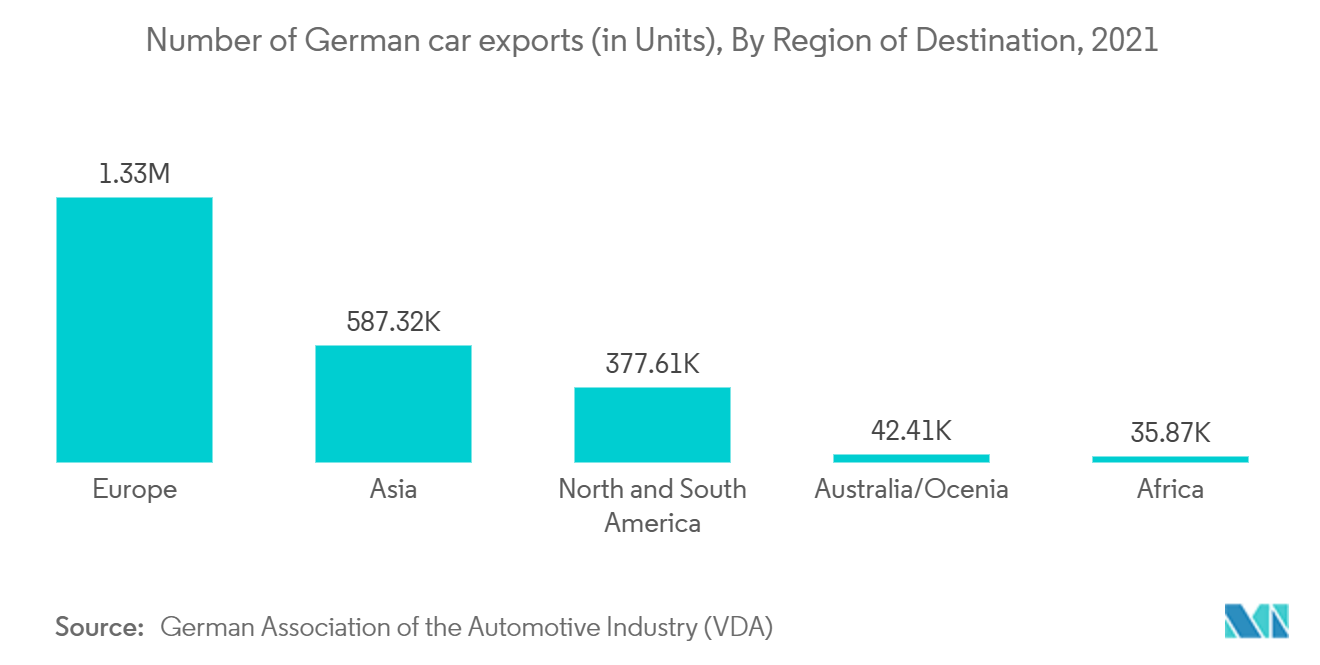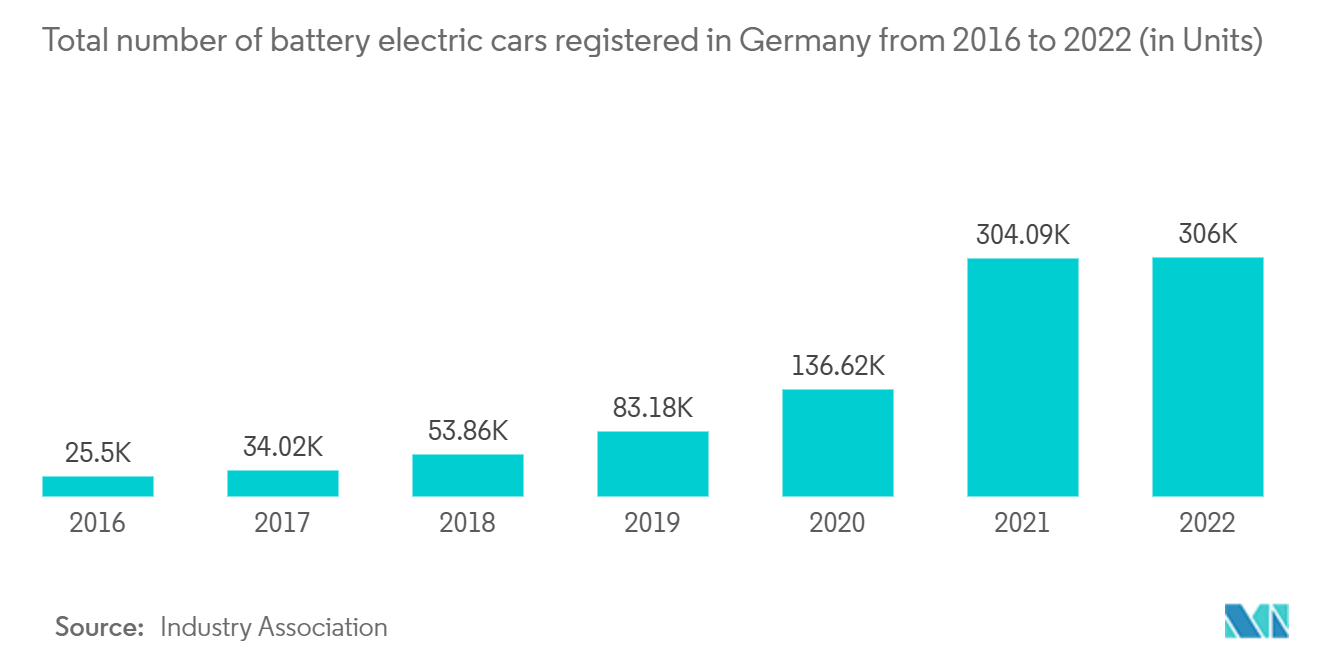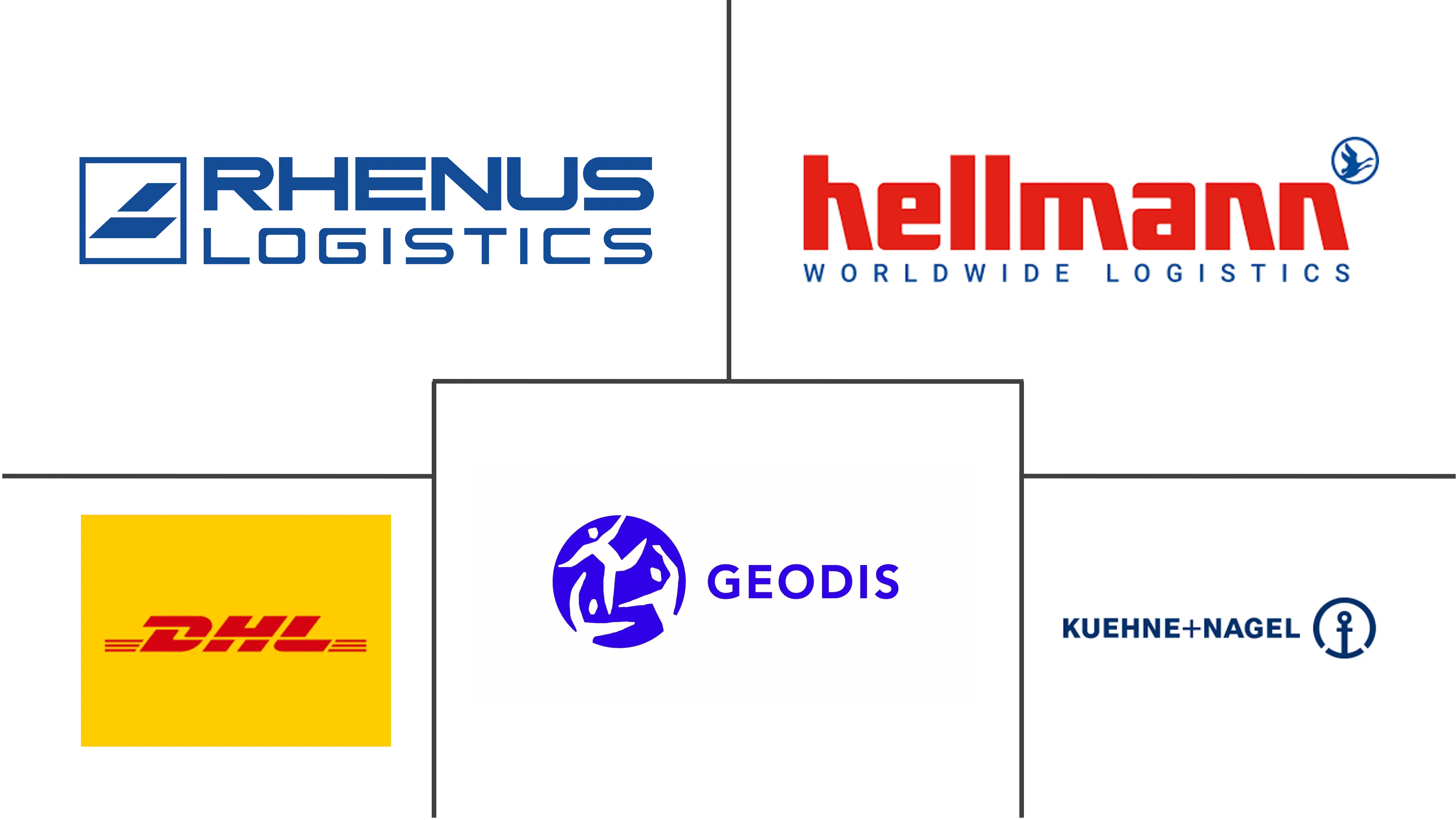
Germany Automotive 3PL Market Analysis by Mordor Intelligence
The Germany Automotive 3PL Market is expected to register a CAGR of greater than 3% during the forecast period.
- Germany is Europe's biggest automotive market, number one in production and sales terms, accounting for around 25 percent of all passenger cars manufactured and almost 20 percent of all new registrations. Germany also boasts the largest concentration of OEM (Original Equipment Manufacturers) plants in Europe. There are currently 44 OEM sites located in Germany. German OEM market share in the EU was more than 55 percent in 2021.
- Germany's auto sector is bouncing back from the COVID-19 pandemic with a broad array of forward-looking instruments and measures that will transform both the industry and future mobility. Significant investment in autonomous driving and battery research and development, massive expansion of charging infrastructure, and electric vehicle cash incentives are driving prospects in the resurgent industry.
- German OEMs were responsible for internal R&D investments amounting to almost EUR 28.3 billion (USD 30 billion) in 2021. Germany's automotive sector is the country's most innovative industry sector, accounting for 34.1 percent of total German industry R&D expenditure of around EUR 71 billion (USD 75.26 billion) in 2020. Research and development personnel within the German automobile industry reached a level of around 134,000. Manufacturers and suppliers in the German automotive industry will invest more than EUR 220 billion (USD 233.2 billion) in electric mobility and digitalization for the period 2022-2026.
- As Germany is a regional hub, it is a preferred location for manufacturers who can benefit from the ecosystem of leading shippers and third-party logistics providers (3PLs) in the country. The demand for warehousing space has expanded in the past decade, and over the forecast period, it is expected to be boosted by growth in regional trade and e-commerce.
- Not only is Germany's logistics infrastructure world-class, but its companies are also global logistics leaders. In fact, the world's largest logistics service provider is a German company, Deutsche Post (DHL). Deutsche Bahn operates Europe's largest rail network, and Lufthansa Cargo is one of the world's leading global air freight companies.
Germany Automotive 3PL Market Trends and Insights
Automotive Exports driving logistics market
Germany is the second most populous and has the largest economy in Europe. There are technically 74 ports in the country, the major ones being the ports of Hamburg, Duisburg, Rostock, and others. Cars are one of the most traded goods in the world, and Germany, going by its reputation in the automobile industry, has always had consistent growth in this segment. Export expectations in the manufacturing sector of Europe's largest economy rose in July, with the automotive industry among the biggest winners. It is a boon for a sector hit hard by the coronavirus pandemic.
Europe was Germany's leading car export partner in 2021, with around 1.3 million vehicles. However, this was a decrease compared to the year before. The German automobile industry is indispensable to the country's image on the international industrial stage. Based on the number of vehicles produced in Germany, Volkswagen was in the lead for several years and was a popular brand in other countries. The German automobile industry saw falling employee numbers in recent years.
During a lockdown, the pandemic stopped production at some sites, which happened when companies were already struggling to move away from diesel- and gasoline-powered cars and toward "green" electric vehicles. This hit the car industry, the main driver of Germany's export-based economy. Daimler flagged signs of recovering demand for top-end Mercedes-Benz models and electric vehicles. Volkswagen expects slight growth in China's premium car segment this year.

Electric vehicles in German automobile market is Driving the Market
According to the German Association of the Automotive Industry (VDA), electric vehicles accounted for 30.4 percent of new vehicle registrations for the first time in October. Germany witnessed the registration of 178,800 cars in October, of which 54,400 were electric vehicles. That's due to the current dynamics of the market. The profit margins for electric vehicles are currently quite high. The German state subsidizes EV purchases with up to 6,000 euros. In August 2021, Germany reached its target of one million registered battery-electric and plug-in hybrid vehicles, per government resources. Volkswagen plans to sell 50% of EVs by 2030 and nearly 100% by 2040, while Daimler, which owns the Mercedes-Benz marque, plans to go all-electric by 2030.
In the first half of 2022, 306,000 e-cars were registered in Germany. This means that every fourth new car already has an electric drive. German corporate brands led the way with a market share of 59 percent. The drivers are battery-electric passenger cars, which account for 55 percent of all new e-car registrations (+13 percent). Three of the top four manufacturers in the domestic e-car market are German companies. Currently, there are already around 80 e-models on offer, and by 2024, this number will almost double to around 150 models. On June 1, 2022, the stock in Germany was around 1.4 million electric cars. The innovation dynamics of the automotive industry can also be seen in the patent statistics. More than half of the patents registered for e-drives come from suppliers and manufacturers in Germany.

Competitive Landscape
The German Automotive 3PL Market is highly competitive. Germany leads in the automobile sector, and domestic automotive third-party logistics companies like Honold are technologically advanced and compete with major international players like Deutsche Post DHL. With important international ports in Germany, the international logistics sector is an important part of the German economy. With a boom in electric and hybrid car markets, the market for the major 3PL companies in the automotive segment is getting more competitive.
Germany Automotive 3PL Industry Leaders
-
Hellmann Worldwide Logistic
-
Rhenus Logistics
-
DHL Post
-
Geodis
-
Kuehne + Nagel International AG
- *Disclaimer: Major Players sorted in no particular order
.webp)
Recent Industry Developments
- October 2023: AD Ports Group (ADX: ADPORTS), one of the world's premier facilitator of logistics, industry, and trade, announces that Noatum, which now leads its Logistics Cluster operations, has signed the agreement for the acquisition of the 100% equity ownership of Sesé Auto Logistics, the Finished Vehicles Logistics (FVL) business of Grupo Logístico Sesé, for a total purchase consideration (Enterprise Value - EV) of EUR 81 million. The transaction is expected to be completed by Q1 2024, subject to regulatory approvals.
- February 2023: Samvardhana Motherson Automotive Systems Group BV (SMRPBV), a 100 % subsidiary of Samvardhana Motherson International (SAMIL), has entered into an agreement to acquire 100% stake in SAS Autosystemtechnik GmbH (Germany) (SAS) from Faurecia, a company of the FORVIA Group. SAS is a leading global provider of assembly and logistics services for the automotive industry. . It has strong customer relationships with leading European and American OEMs, some of which span almost 3 decades.
Germany Automotive 3PL Market Report Scope
Automotive third-party logistics companies provide services that have to do with the automotive logistics of the supply chain. This includes transportation, warehousing, picking and packing, inventory forecasting, order fulfillment, packaging, and freight forwarding. A 3PL (third-party logistics) provider offers outsourced automotive logistics services, which encompass the management of one or more facets of procurement and fulfillment activities. In business, 3PL has a broad meaning that applies to any service contract that involves storing or shipping items. A 3PL service may be a single provider, such as transportation or warehouse storage, or it can be a systemwide bundle of services capable of handling supply chain management.
The Germany Automotive 3PL Market is segmented by service (transportation, warehousing, distribution, inventory management, and other services) and by type (finished vehicles and auto components). The report offers market sizes and forecasts for the Germany Automotive 3PL Market in value (USD) for all the above segments.
| Finished Vehicle |
| Auto Component |
| Transportation |
| Warehousing, Distribution, and Inventory Management |
| Other Services |
| By Type | Finished Vehicle |
| Auto Component | |
| By Service | Transportation |
| Warehousing, Distribution, and Inventory Management | |
| Other Services |
Key Questions Answered in the Report
What is the current Germany Automotive 3PL Market size?
The Germany Automotive 3PL Market is projected to register a CAGR of greater than 3% during the forecast period (2025-2030)
Who are the key players in Germany Automotive 3PL Market?
Hellmann Worldwide Logistic, Rhenus Logistics, DHL Post, Geodis and Kuehne + Nagel International AG are the major companies operating in the Germany Automotive 3PL Market.
What years does this Germany Automotive 3PL Market cover?
The report covers the Germany Automotive 3PL Market historical market size for years: 2019, 2020, 2021, 2022, 2023 and 2024. The report also forecasts the Germany Automotive 3PL Market size for years: 2025, 2026, 2027, 2028, 2029 and 2030.
Page last updated on:
Germany Automotive 3PL Market Report
Statistics for the 2025 Germany Automotive 3PL market share, size and revenue growth rate, created by Mordor Intelligence™ Industry Reports. Germany Automotive 3PL analysis includes a market forecast outlook for 2025 to 2030 and historical overview. Get a sample of this industry analysis as a free report PDF download.



